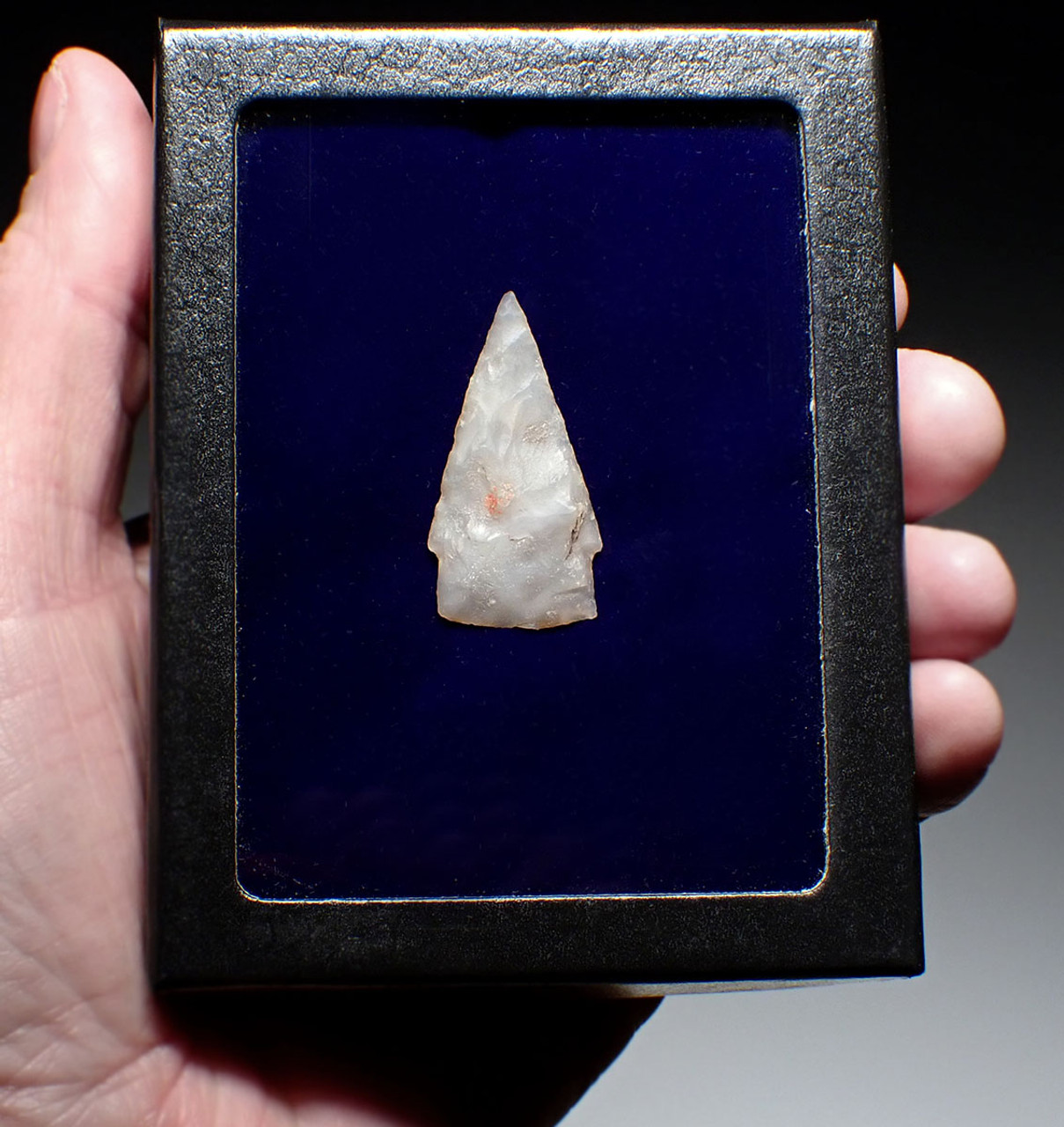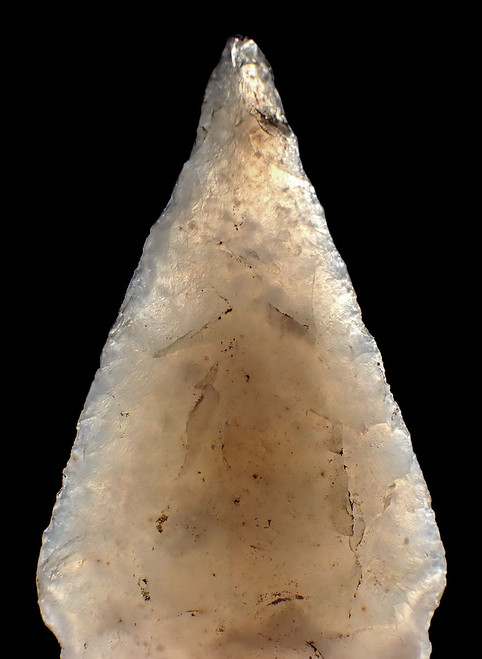Product Description
SEE MORE PRE-COLUMBIAN WEAPONS AND TOOLS
Fine quality Pre-Columbian Aztec projectile points are scarce and highly sought after by advanced collectors. This FINEST COLLECTOR-GRADE undamaged Aztec atlatl tlacochtli spear point is made of RARE translucent CHALCEDONY, a prized lithic most often associated with prestige and ceremonial use. An additional rare feature is that it has traces of red cinnabar on one side. Pre-Columbian objects pigmented with cinnabar provide concrete evidence of ritual purpose. Cinnabar, a crimson mercury sulfide mineral, was heavily used by the ancient Maya and Aztec civilizations for decorative and ceremonial purposes, particularly for its vibrant red color. They associated the color red with blood and life force, making cinnabar a sacred substance. Cinnabar was incorporated into burial rituals and sacrifice offerings. Cinnabar was believed to be able to animate an object, or even the dead. By placing cinnabar pigment on a projectile point, it indicates it was marked for ceremony. Perhaps to impart a soul to it, as an offering to a god, warrior-chief, or a royal gift. Often, any pigment like this rarely survives the ravages of time to a degree this has.
This arrowhead is a square base DELTA bifacial projectile point from the Pre-Columbian Aztec Empire. Masterful pressure-flaking across the entire projectile point has yielded stunning results which are highlighted when this piece is held to the light. The needle-sharp tip is so amazingly sharp and symmetrical, it is no doubt this was a prestige point. The thinness further demonstrates the extreme talent of the original stone-knapper who made this as it defies explanation how the point was made without breaking. One of the best specimens of this type we have seen, and perfectly intact without any breakage!
For discriminating collectors of rare Aztec weapons, this is a prize arrowhead unlike any we have offered before. All surfaces display impacted sediment and mineral patina deep in microscopic crevices - traits ONLY seen in AUTHENTIC SPECIMENS.
The Atlatl or Spear (Dart) Thrower was a weapon used to hurl darts called "tlacochtli" with greater force and from greater range than they could be thrown by hand. This weapon was considered by the Aztecs to be suited only for royalty and the most elite warriors in the army, and was usually depicted as being the weapon of the Gods. Murals at Teotihuacan show warriors using this effective weapon and it is characteristic of the Mesoamerican cultures of central Mexico. Warriors at the front lines of the army would carry the atlatl and about three to five throwing darts which they would launch after waves of arrows and sling projectiles as they advanced into battle before engaging into melee combat. The "darts" launched from an Atlatl were more like big arrows about 5.9 feet long. Tipped with obsidian, chert, bone or copper heads.
HISTORY
While many ancient civilizations remain a mystery, little can be left to conjecture when it comes to the details of the Aztec way of life. An extensive and detailed collection of written and pictorial records exist for us today called CODICES (CODEX if singular) were produced before Spanish contact by the native tribes themselves, and afterwards during the Colonial period. These codices were created by the Aztecs in pictorial form, as well as by other indigenous tribal sources, all of which had no written language. Colonial era codices exist in greater number with roughly 500 separate codices known, showing extensive pictograms as well as being written in Spanish, Latin and in the original Nahuatl language.
The origin of the Aztec (Azteca) Empire is legendary. Aztec codices record that they began their wandering journey in 1100 A.D. emerging from their former homeland called Aztlan or "place of the herons", an island in a lake where men went out to fish from boats. The exact location of this region is not known but other than it was northwest of present-day Mexico City, the former center of the Aztec empire, but how far, it is a mystery.
The Aztecas believed they were guided by a blood-thirsty deity they called Huitzilopochtli who communicated to them through four priest-chieftains called teomama. Their god called upon them for his insatiable thirst for human blood and sacrifice. As they migrated south, every indigenous Indian tribe they encountered along the way abhorred the Azteca, as they were known, as they were reviled and scorned for their violent and barbaric ways. During their migration, Huitzilopochtli gave a message to his people that their new identity would no longer be known as Azteca but as Mexica. In around 1325 A.D., as they were fleeing an altercation with the Culhuacans, they were driven to a marsh. Their god Huitzilopochtli consoled them that evening and said he would end their wandering and told them to look for a sign that he will give them that will signify their new homeland which will be "the place of the cactus and the eagle I now name Tenochtitlan". They next day they witnessed an eagle resting on a prickly pear cactus which they interpreted to be the sign they were hoping for.
This marsh, Lake Texcoco, would later become a vast canal-laced highly advanced, super city of stone pyramids and temples known as Tenochtitlan. With a population that grew to an estimated 200,000 people (three times the largest city of Spain at the time!) this became the center of the most powerful and militaristic empire of Mesoamerica - home of the Aztecs. Today, we classify their reign as occupying the Late Post Classic Period from 1250 - 1521 A.D.
The success and rise of the Aztec empire was largely attributed to their dominance through intimidation of their surrounding neighbors from whom they extracted resources from. The effect of their extreme militarism and brutality on their enemies brought a large region of peoples into submission. The highly advanced and complex Aztec social structure, as well as legal system, kept their growth intact and the society orderly. They formed an alliance with the Texcoco and Tlacopan tribes and in 1428 A.D., they defeated the Tepaneca. This triple alliance established a great empire that was predominantly ruled from Tenochtitlan. At its peak, this empire included a large, diverse group of people and spanned an area from the entire Central Mexico region south, into northern Guatemala.
References:
- Fiedel, Stuart J., Prehistory of the Americas, 1992 - Freeman and Company, Early Man in America, 1973
- Hirth Kenneth, Obsidian Craft Production in Ancient Central Mexico, 2006
- Muser, Curt, Facts and Artifacts of Ancient Middle America, 1978
- Phillips, Charles, The Complete Illustrated History of the Aztec and Maya, 2008
- Pohl, John M.D., Aztec, Mixtec and Zapotec Armies. Oxford: 1991
- Schmal, John P., The History of the Indigenous Sinaloa. 2004 - Stuart, Gene, The Mighty Axtecs, 1981
 US DOLLAR
US DOLLAR
 EURO
EURO
 AUSTRALIAN DOLLAR
AUSTRALIAN DOLLAR
 CANADIAN DOLLAR
CANADIAN DOLLAR
 POUND STERLING
POUND STERLING














